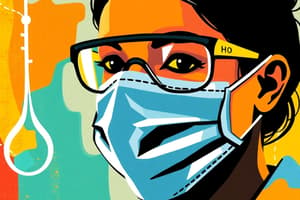Podcast
Questions and Answers
What is the primary goal of chemical laboratory safety?
What is the primary goal of chemical laboratory safety?
- To increase the use of chemicals in experiments
- To minimize hazards to personal health and the environment (correct)
- To create complex chemical reactions safely
- To enhance productivity in chemical experiments
Which of the following is NOT a component of proper laboratory design?
Which of the following is NOT a component of proper laboratory design?
- Adequate ventilation system
- Slope of floors towards drains
- Accessible entry and exit points
- Presence of an art mural (correct)
Why is personal protective equipment crucial in a laboratory setting?
Why is personal protective equipment crucial in a laboratory setting?
- It increases efficiency in conducting experiments
- It protects against injuries to the eyes, skin, and respiratory system (correct)
- It ensures that all chemicals are used properly
- It minimizes the need for emergency equipment
What is an example of a spill control material that should be available in a laboratory?
What is an example of a spill control material that should be available in a laboratory?
Which safety equipment is essential for dealing with fire hazards in the laboratory?
Which safety equipment is essential for dealing with fire hazards in the laboratory?
Study Notes
Laboratory Design
- The laboratory design should meet the needs of the laboratory's functions.
- Doors allow for easy entry and exit.
- Laboratory benches should have a sink, water supply, and a U-shape.
- The Ventilation system should include windows, fans, fume hoods, and biological safety cabinets.
- Lighting should be on the level of the lab and the level of the bench.
- Floor drains should be near the units, and the floor should be sloped to the drain to avoid slip hazards.
- Spill control materials include spill kits and sand.
- Safety equipment includes eyewash units, fire blankets, and fire extinguishers.
Personal Protective Equipment (PPE)
- Eyes, skin, respiratory and digestive tracts are most exposed to laboratory hazards.
- PPE includes lab coats, gloves, eye goggles, dust masks, and respirators.
- Shoes should be made of non-porous material with closed toes and heels and high heels are discouraged.
- Contact lenses are discouraged, but goggles or face shields are recommended if worn.
- Keep all long hair tied back when working with open flames.
Laboratory Behavior
- Always follow lab procedures exactly.
- Never do an unauthorized experiment.
- Keep your working area clean.
- No food or drink is allowed in the laboratory, and smoking is prohibited.
- Avoid practical jokes.
- All contaminated PPE must be removed and properly disposed of before leaving the laboratory.
- Use the "beaking method" when removing gloves to avoid contamination.
- The most dangerous thing in any laboratory is not knowing how to use chemicals or what they are.
Laboratory Hazards
- Chemical Hazard: Pay attention to hazard signs, symbols, and labels.
- Fire Hazard: Know how to use a fire extinguisher, it must be readily available.
- Sharp Objects Hazard: Never try to catch broken instruments, use forceps, and dispose of broken glass in designated containers.
- Electrical Hazard: Keep all electrical cords, wires, and appliances away from water.
- Physical Hazard: Handle all equipment carefully, and avoid clutter on the lab desk and floor.
- Biological Hazards: Autoclave before disposing of biological waste, and store in safe containers.
- Heating Hazard: Never point a heated test tube at yourself or others, do not heat closed containers, use tongs or gloves to handle heated glassware, and never place hot glassware directly in cold water, or look into a container while heating.
Dealing with Chemicals
- Material Safety Data Sheet (MSDS): Obtained from the chemical manufacturer and provides essential safety info for hazardous chemicals.
- Chemical Safety Rules: - Read all labels carefully, only use the instructed type and amount of chemical, never touch, taste, or smell chemicals, never mix chemicals unless instructed, transfer chemicals carefully, when diluting acid pour acid into water, and consider all chemicals dangerous.
- Chemical Waste Disposal: Follow proper disposal procedures. Acids and bases should be neutralized.
- New Hazard Communication Standard: Laboratories must have a written hazard communication program, readily available MSDS, annual education, and hazard warning labels on containers.
Emergency Procedures
- Acid/Base Spills: Know how to deal with concentrated acid and base spillage.
- First Aid: - Skin: In case of skin contact, rinse with water for 15 minutes. - Eye: Use an eyewash station for eye contact. Apply local anti-inflammatory drugs if necessary.
- Floor Spills: Use laboratory spill kits, dilute with water, and neutralize acids and bases with a suitable solution.
- Bench Spills: Use a designated spill kit for spills on benches.
Studying That Suits You
Use AI to generate personalized quizzes and flashcards to suit your learning preferences.
Related Documents
Description
This quiz covers essential laboratory design elements and personal protective equipment (PPE) necessary to ensure safety and functionality in a laboratory environment. It emphasizes the importance of proper layout, ventilation, safety equipment, and appropriate PPE for laboratory personnel. Test your knowledge on key features and safety protocols for effective lab operations.




